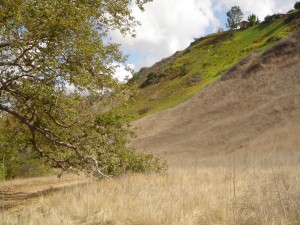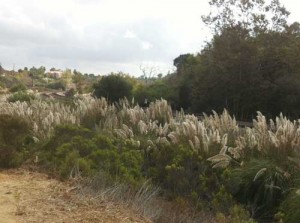
Ice plant “invading” Marian Bear Memorial Park from a Clairemont backyard. Most homeowners don’t realize the detrimental impacts of exotic invasive species on native plants and wildlife.
Photo: San Diego Earthworks
According to the organization PlantRight , the control of non-native invasive species costs California $85 million every year. These invasives have “escaped” from landscaped areas over many years and invaded our parks and natural spaces, causing a variety of problems. Pampas grass and non-native tree such as palms and eucalyptus are prime examples of non-native species that have invaded many of San Diego’s natural areas including the Rose Creek Watershed.
Invasive plants create serious fire hazards and crowd the native plants that provide homes for wildlife. They also lead to flooding, landslides and poor water quality of our creeks, rivers and bays. Problematic pests such as rats particularly love to make nests in pampas grass. In some areas, invasive plants are so densely grown that they have created places in which people engaged in illegal activities can hide. The invasive plants’ seeds move in the wind and water, making it difficult to control them unless a comprehensive approach is taken.
Much of the native vegetation in the Rose Creek Watershed has been disturbed by exotic invasive species as a result of urban development. For example:
- Tamarisk , also known as salt cedar, infests 1.5 million acres of wetland and river areas throughout the American southwest. These trees use more water than native species and damage the soil.
- Arundo , also known as giant reed, fuels dangerous wildfires, causes local flooding, consumes more water than natives, and destroys critical habitat for wildlife.
- Pampas grass invades and degrades habitats along the entire California coastline.
- Eucalyptus has fueled disastrous fires in the Oakland hills, Santa Barbara, and elsewhere.

